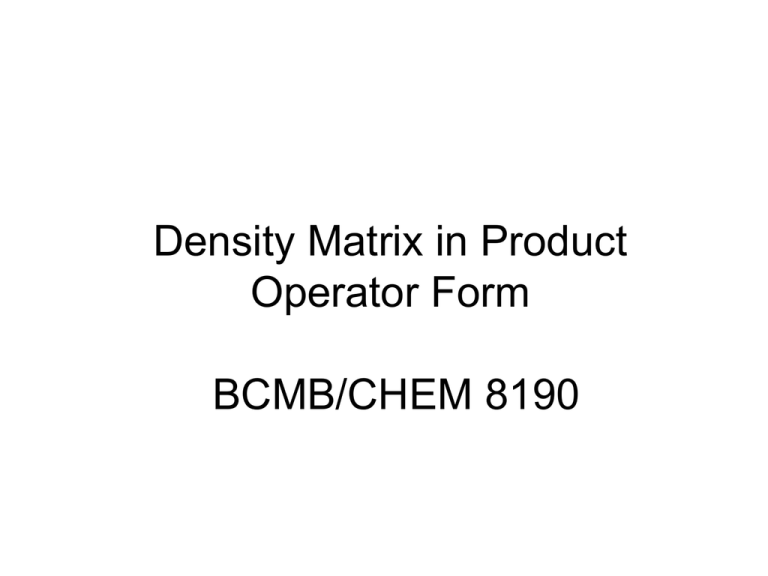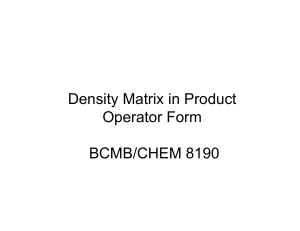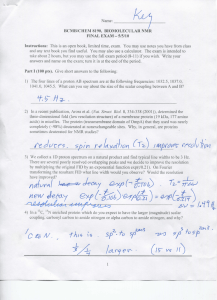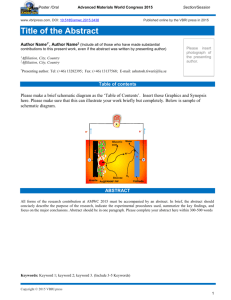Density Matrix in Product Operator Form BCMB/CHEM 8190
advertisement

Density Matrix in Product
Operator Form
BCMB/CHEM 8190
Product Operators: Connection to
Density Matrix Properties
• For small deviations it is convenient to work with
a deviation density matrix, | | = | | - 1/Z| E |
(E is identity matrix)
• | | is also just a collection of numbers; product
operators are specific subsets of these numbers.
• Some subsets are associated with observables; ie.
12, 21, 34, 43, dictate Mx and My for A spin of an
AX system
• Some sets transform cleanly to other sets under rf
pulses; ie. 11, 22 -> 12, 21 under a 90°x pulse
(actually linear combinations of these)
Expressing in a basis set of matrices
•
Rationale: collect elements with common evolution and
transformation properties in each basis matrix
•
(t) = s bs(t) BS. But with certain requirements: Hermitian;
ij = ij*; ii real , # basis matrices = # elements, orthogonal
•
Example for a single spin ½:
1 1 0
2 0 1
½E=
IZ =
1 1 0
2 0 1
1 0 1
2 1 0
1 0 i
2 i 0
IY =
IX =
• Look just like matrix representation of corresponding
operators – hence name product operators – but actually
elements
Representation of some simple
density matrices
• What about eq?
eq
0
1
I Z
2 0
• What about after a /2 pulse on +X axis?
0
i
1
( )
I Y
2
2 i 0
• Note the simple conversion of one product
operator (part of a density matrix) to another
operator (part of a density matrix) under an rf pulse
Transformation for an arbitrary pulse on X
• exp(-i1t IX) IZ exp(i1t IX) = IZ cos(1t) - IY sin(1t)
• Note: H’ = -B1 IX t
• Hence, above 1t for positive B1 would be
negative. Convention is not to specify sign by B1
direction on axis but to do so by sign of the rotation
that occurs. This makes product operator
transformations look opposite of our Bloch
equation description.
• A positive 90 degree rotation about X converts IZ to
– IY; a 90 degree rotation with field in +X direction
converts MZ to MY.
Product Operators for Two Spin Case
• q=0
½E
• q=1
I1X, I1Y, I1Z, I2X, I2Y, I2Z
• q=2
2I1XI2X, 2I1XI2Y, 2I1XI2Z,
2I1YI2X, 2I1YI2Y, 2I1YI2Z,
2I1ZI2X, 2I1ZI2Y, 2I1ZI2Z,
• Note: 16 operators (pieces of )
16 elements in 2 spin (4X4) density matrix
Two-Spin Cartesian Product Operators
Howarth et al., JMR 68, 433-452 (1986)
½E
½
I1z
2 I1zI2z
1
0
0
0
1
0
0
0
1
0
0
0
1
0
0
0
0
1
0
0
0
1
0
0
0
-1 0
0
0
-1 0
0
0
0
1
0
0
0
-1 0
0
0
1
0
0
0
-1 0
0
0
0
1
0
0
0
0
0
0
-1
0
0
0
½
I1x
½
I2z
-1
I1y
½
½
2 I1xI2z
1
2 I1yI2z
0
0
1
0
0
0
-i
0
0 0
1
0
0
0
-i
0
0
0
0
1
0
0
0
-i
0 0
0
-1
0
0
0
i
1
0
0
0
½ i
0
0
0
½ 1 0
0
0
½ i
0
0
0
0
1
0
0
0
i
0
0
0 -1 0
0
0
-i
0
0
Two-Spin Cartesian Product Operators
(continued)
Note: for heteronuclear often use I and S instead of I1 and I2
I2x
½
I2y
2 I1zI2y
0
1
0
0
0
-i
0
0
0
1
0
0
0
-i
0
0
1
0
0
0
i
0
0
0
1
0
0
0
i
0
0
0
0
0
0
1
0
0
0
-i
0
0
0
-1
0
0
0
i
0
0
1
0
0
0
i
0
0
0
-1 0
0
0
-i
0
½
2 I1xI2x
½
2 I1zI2x
½
2I1yI2y
2 I1xI2y
½
2 I1yI2x
0
0
0
1
0
0
0
-1
0 0
0
-i
0
0
0
-i
0
0
1
0
0
0
1
0
0 0
i
0
0
0
-i
0
0
1
0
0
½ 0
1
0
0
½ 0 -i 0
0
½ 0
i
0
0
1
0
0
0
-1 0
0
0
0
i
0
0
0
i
0
0
Physical interpretation of Product Operators
I1z + I2z is proportional to equilibrium population
(basis set order: , , , ): 11 = has excess
½
1
0
0
0
1
0
0
0
0
-1 0
0
0
0
0
0
-1 0
0
0
1
0
0
0
0
0
0
0
0
0
-1
0
0
0
-1
1
0
0
0
0
1
0
0
0
0
0
0
+½
-1
=
I1x is obvious; if is proportional to Ix, x magnetization exists.
Mx = Tr {| | (h/2) |Ix|} =
(h/2)/4 Tr{
0
0
1
0
0
0
1
0
1
0
0
0
0
0
0
1
0
0
0
1
0
1
0
0
1
0
0
0
1
0
0
0
0
0
1
0
0
1
0
0
0
1
0
0
0
0
0
1
} = (h/2)/4 Tr
= (h/2)
What about 2 I1xI2z?
Note: we can generate 2 I1xI2z from I1x and I2z by multiplication
½
0
0
1
0
0
0
0
1
1
0
0
0
0
1
0
0
• ½
1
0
0
0
0
-1 0
0
0
0
1
0
0
0
0
-1
=
0 0
1
0
0 0
0
-1
1 0
0
0
0 -1 0
0
Result is much like I1x, but with reversal of some signs.
We can associate elements with particular lines; 13 =
This is transition of the first spin with second . 24 =
is a transition of the first with the second spin : first doublet
| I1x | =
| 2 I1xI2z | =
What about 2I1XI2X?
0
0
2 1 1
2
2 1
0
2 I 1Y I 2 Y
0
0
0
1
0
0
0
1
0
0
1
0
1
0
0
0
0 0
1 1
0 0
0 0
0 1
1 0
0 0
0 0
1
0
0
0
0
0
0
1
0
0
0 1 0
2 0
1
0
1
Two Q,
0
0
1
0
0
1
0
0
1
0
0
0
Zero Q
• Linear combination of 2 is pure Zero Q or Two Q
2I1XI2X - 2I1YI2Y = Two Q
• 2I1XI2Y, 2I1YI2X, are imaginary components
Transformation properties come from
rotation operators
• X pulse by angle 1t =
IZ >(IX) IZ cos(1t) - IY sin(1t)
IY >(IX) IY cos(1t) + IZ sin(1t)
IX >(IX) IX
• Free precession:
IX >(IZ) IX cos(t) + IY sin(t)
IX >(2J I1Z I2Z) IX cos(Jt) + I1Y I2Z sin(Jt)
Transformations Caused by Various Evolution Operators
Product Oper.
I1x + I2x
I1y +I2y
I1z +I2z
2 I1zI2z
½E
½E
½E
½E
½E
I1z
-I1y
I1x
I1z
I1z
I2z
-I2y
I2x
I2z
I2z
2 I1zI2z
(2 I1yI2y)
(2 I1xI2x)
2 I1zI2z
2 I1zI2x
I1x
I1x
-I1z
I1y
2 I1yI2z
I1y
I1z
I1y
-I1x
-2 I1xI2z
I2x
I2x
-I2z
I2y
2I1zI2x
I2y
I2z
I2y
-I2x
-2 I1zI2x
2 I1xI2z
-2 I1xI2y
(-2 I1zI2x)
2 I1yI2z
I1y
2 I1yI2z
(-2 I1zI2y)
2 I1yI2x
-2 I1xI2z
-I1x
2 I1zI2x
-2 I1yI2x
(-2 I1xI2z)
2 I1zI2y
I2y
2 I1zI2y
(-2 I1yI2z)
2 I1xI2y
-2 I1zI2x
-I2x
2 I1xI2x
2 I1xI2x
(2 I1zI2z)
---
2 I1xI2x
2 I1yI2x
2 I1zI2x
-2 I1yI2z
---
2 I1yI2x
2 I1xI2y
2 I1xI2z
-2 I1zI2y
---
2 I1xI2y
2 I1yI2y
(2 I1zI2z)
2 I1yI2y
---
2 I1yI2y
Evolution is to 2, 4( ), or more ---. Coefficient is sin of , Jt, or t.
Application of Product Operators:
2D, 2Q Spectrum
• Can we excite a 2Q coherence? Can we detect it?
• Consider:
90X 180Y
90X
with = 1/(4J)
(removes chem shift)
• I1Z + I2Z >(IX+IX, 90) -I1Y –I2Y >(JI1ZI2Z, )
2I1XI2Z + 2I1ZI2X >(IX+IX, 90) -2I1XI2Y - 2I1YI2X
ZQ and 2Q evolution -- also gives -2I1XI2X etc
• Consider detection:
90X
• 2I1XI2Y >(IX+IX, 90) -2I1XI2Z + others –> 1Q detect
• 2I1YI2X >(IX+IX, 90) -2I1ZI2X + others –> 1Q detect
Example: -Me-Galactose
OH
O
1
4
HO
Me
2 OH
3
OH




